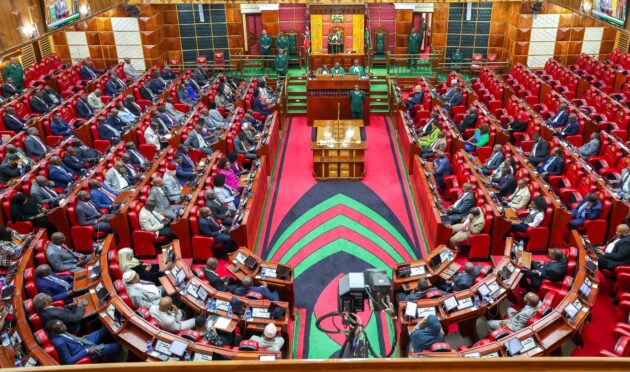
MPs Open Inquiry into Toxic Waste Dumping as Cancer Cases Surge in North Eastern » Capital News
NAIROBI, Kenya Jun 24 – A parliamentary inquiry is underway following alarming reports that over 2,400 people in North Eastern region have been diagnosed with cancer in just the last three years, with leaders and residents linking the surge in cases to suspected toxic and nuclear waste dumping dating back to the 1980s and 1990s.
The National Assembly’s Environment and Forestry committee began hearings in response to a request for a statement by Wajir South MP Mohammed Adow.
The inquiry seeks to establish the extent and impact of alleged hazardous waste dumping across counties, including Garissa, Wajir, and Mandera.
“There have been claims in the recent past that sometime in the late 1990s, the Government, through the Ministry of Energy, okayed the dumping of toxins, including nuclear waste in the North Eastern region. Research has proven that nuclear waste is associated with high cases of cancer,” Adow said.
According to Garissa Governor Jama who appeared before the committee,Garissa’s Regional Cancer Centre, which began full operations in 2023, recorded 440 cases in its first year, 1,347 in 2024, and at least 640 new cases in the first half of 2025.
The facility serves as a referral hub for over 10 counties across Northern Kenya, as well as parts of Somalia.
“It’s an opportunity to thank you and your members for bringing this to the fore.This is an issue that has haunted the people of northern Kenya for many years. Every elder who lived from the 1980s will tell you, dumping was done,” said Jama.
The Garissa governor warned that contaminated groundwater often collected in surface ponds shared by people and livestock may be the pathway for carcinogenic exposure, potentially tied to improperly disposed nuclear material.
“If we were to analyze further, it’s possible that esophagus cancer cases could be linked to radioactive waste seeping into the soil and water. This must be thoroughly investigated,” Jama stated
“These numbers are extremely disturbing. Most of the cases are from rural communities, and many are esophageal cancers a type strongly linked to water contamination,” he added.
Jama also demanded the summoning of Former Minister for Rural Development Cyrus Jirongo who served during President Daniel Moi administration to give evidence over the matter following his revelations that indeed nuclear waste was being deposited in the Northern Eastern region.
“Probably as a matter of priority, get on board a gentleman known by the name of Mr. Jirongo, if that is possible. Because I personally listened to him one time on TV, talking about this matter with some degree of concern and confidence that dumping was done in northern Kenya,”the county boss stated.
The inquiry will seek to confirm whether toxic or radioactive materials were illegally deposited in the arid lands of North Eastern Kenya during the late 20th century which they lamented was a period marked by limited regulatory oversight and minimal local awareness.
The joint committee has already received a memorandum from the Wajir County Assembly following a tour of the six sub-counties, where elders and local residents recounted incidents of mysterious dumping by foreign contractors.
The memorandum indicated in areas where dumping was reported, locals say they observed marked containers and strange equipment, but lacked the knowledge to understand the contents.
“Due to the low literacy levels at the time, many workers couldn’t read warning labels.But the waste was there and now the consequences are surfacing,”the memorandum read.
Chairperson Vincent Kawaya decried what he termed as decades of inaction and institutional neglect. He faulted successive administrations and regulatory agencies for failing to act on longstanding suspicions of illegal toxic dumping in the region, despite repeated complaints from local leaders and residents.
“This is a matter that should have attracted military attention leave alone the Ministry of Health’s because it is a security matter…Kenya has not had any nuclear installation meaning that the waste came from another country and it was dumped here,”
“We will find those who imported the hazardous material into the country and they will be held accountable,”Kawaya stated.
The committee vice chair Charles Kamuren (Baringo South ) assured of the inquiry veracity to ensure all those culpable including companies are brought to book as the constitution guarantees every Kenyan the right to a clean and healthy environment
“That it is not right when we are talking about nuclear power plant that weren’t established in Kenya, using over 500 billion Kenya shillings, while others are suffering as a result of the nuclear waste. Where is the logic here? Where is the balance here?” Kamuren posed.
Turkana Central MP Joseph Emathe highlighted that despite the country signing several treaties on hazardous waste previous regime haven’t sustainably handled waste calling for an inquiry that will ensure people from the North Eastern region obtain justice.
“And this is something that can even attract a scientific research such that we are able to identify which places were polluted. And we link it with the current numbers or data that we are receiving on the cancer patients in that area.There is hopelessness in this region,”Emathe noted.
Njoro MP Charity Chepkony raised concerns on state sanctioned neglect following assertions of nuclear contamination which commenced in the 1990s without remedial measures to help the locals affected by the menace.
“Which action is to be taken in relation with this? And who are these companies? I don’t think the companies which did this, they live in a vacuum. They must be somewhere,”
“There must be contact somewhere. Information about them is real. Therefore, we should ask ourselves, what are we doing? What plans do we have when we come to the matter of compensation?”she posed.
The house team is set to embark on a fact-finding mission to identify the exact locations of suspected dumping, assess the environmental and health effects, and develop a compensation mechanism.